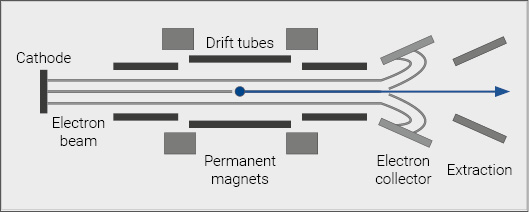PRINCIPLE OF OPERATION
The ion production in an EBIS is based on electron impact ionization in a high-density electron beam which is compressed by a strong magnetic field produced by permanent magnets. An electron gun with a cathode of high emissivity produces the electron beam. The ions which are produced by successive electron impact ionization inside the electron beam are radially confined by the negative space charge of the electron beam. Axial confinement of the ions is achieved by superposition of electrostatic potentials generated using a minimum of three collinear drift tubes. The higher potentials of the outer drift tubes create an axial electrostatic trap. Hence, the ionization time of the ions can be controlled by periodically switching the axial trap potentials on and off.
The magnetic field for electron beam compression is generated by a special magnet system which consists of permanent magnet rings. The electron beam is dumped in an electron beam collector where the electrons are separated from the extracted ions. Usually EBIS are equipped with one or more radial ports. This allows for spectrometry of electromagnetic radiation produced in the region of the ion trap during the ionization process.

Figure 1: Principal operation scheme of an electron beam ion source (EBIS).
RELATED PRODUCT VIDEOS:
Animation how to produce highly charged ions with an EBIS:


